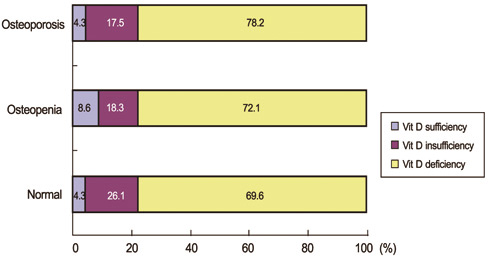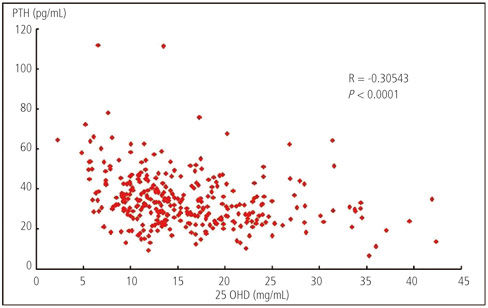The serum vitamin D nutritional status and its relationship with skeletal status in Korean postmenopausal women
- Affiliations
-
- 1Department of Obstetrics and Gynecology, Chung-Ang University College of Medicine, Seoul, Korea. hmpark@hananet.net
- 2Department of Obstetrics and Gynecology, Sungkyunkwan University College of Medicine, Seoul, Korea.
- 3Department of Endocrinology and Metabolism, Kyung Hee University College of Medicine, Seoul, Korea.
- KMID: 2078018
- DOI: http://doi.org/10.5468/KJOG.2011.54.5.241
Abstract
OBJECTIVE
The purpose of this study was to evaluate the nutritional status of vitamin D and its relationship with skeletal status in postmenopausal Korean women.
METHODS
We studied 322 ambulatory postmenopausal women recruited in Seoul, Korea. The research was performed from October 2008 to March 2009. Serum 25-hydroxyvitamin D (25[OH]D) concentration was measured by radioimmunoassay and serum parathyroid hormone (PTH) level was measured by immunoradiometric assay. The bone mineral densities were measured at the lumbar spine and femur using dual energy x-ray absorptiometry.
RESULTS
The mean serum 25(OH)D level was 16.0 +/- 7.1 ng/mL and the mean serum PTH level was 34.0 +/- 13.7 pg/mL. About 90% of all studied postmenopausal women were in vitamin D inadequate status. Although serum vitamin D level was the lowest in osteoporotic postmenopausal women, no significant differences were found in serum level of vitamin D among normal, osteopenic, and osteoporotic women (P =0.4689). Vitamin D level in elderly women over 65 years was significant lower than non-elderly women (P =0.0011). But no significant differences were found in vitamin D levels between early and late postmenopausal women (P =0.9882). Serum vitamin D level in winter and spring was significantly lower than serum vitamin D level in autumn (P < 0.0001). Serum vitamin D level was negatively correlated with serum PTH level (r = -0.3054, P < 0.0001).
CONCLUSION
About three quarters of postmenopausal women were in vitamin D deficient status regardless of the status of bone health. Therefore, it is recommended to prescribe the supplemental vitamin D to improve bone health of postmenopausal Korean women.
Keyword
MeSH Terms
Figure
Cited by 4 articles
-
Dietary factors affecting bone mineral density in Korean rural postmenopausal women
Jeong Sook Choe, Eun Mi Ahn, Sung Ok Kwon, Young Hee Park, Jinyoung Lee
Korean J Nutr. 2012;45(5):470-478. doi: 10.4163/kjn.2012.45.5.470.Effect of Vitamin D Supplementation on the Physiological Indices, Muscle Mass, and Physical Functions of Aged Women
In Kyung Kim, Ok Soo Kim
Korean J Adult Nurs. 2013;25(5):539-548. doi: 10.7475/kjan.2013.25.5.539.Vitamin D deficiency is an independent risk factor for cardiovascular disease in Koreans aged ≥ 50 years: results from the Korean National Health and Nutrition Examination Survey
Sunmin Park, Byung-Kook Lee
Nutr Res Pract. 2012;6(2):162-168. doi: 10.4162/nrp.2012.6.2.162.Vitamin D intake and bone mineral density in Korean adults: analysis of the 2009–2011 Korea National Health and Nutrition Examination Survey
Hyejin You, Hye Ran Shin, SuJin Song, Sun Yung Ly
Nutr Res Pract. 2022;16(6):775-788. doi: 10.4162/nrp.2022.16.6.775.
Reference
-
1. Parfitt AM, Gallagher JC, Heaney RP, Johnston CC, Neer R, Whedon GD. Vitamin D and bone health in the elderly. Am J Clin Nutr. 1982. 36:1014–1031.2. Johnell O. The socioeconomic burden of fractures: today and in the 21st century. Am J Med. 1997. 103:20S–25S.3. Walters MR. Newly identified actions of the vitamin D endocrine system. Endocr Rev. 1992. 13:719–764.4. Lemire JM. Immunomodulatory actions of 1,25-dihydroxyvitamin D3. J Steroid Biochem Mol Biol. 1995. 53:599–602.5. Park HM, Kim JG, Choi WH, Lim SK, Kim GS. The vitamin D nutritional status of postmenopausal women in Korea. Korean J Bone Metab. 2003. 10:47–55.6. Kim H, Ku SY, Kim SH, Choi YC, Moon SY, Kim JG. A study of vitamin D insufficiency in postmenopausal Korean women. J Korean Soc Osteoporos. 2003. 1:12–21.7. Holick MF. Vitamin D deficiency. N Engl J Med. 2007. 357:266–281.8. Wortsman J, Matsuoka LY, Chen TC, Lu Z, Holick MF. Decreased bioavailability of vitamin D in obesity. Am J Clin Nutr. 2000. 72:690–693.9. Hercberg S, Galan P, Preziosi P, Bertrais S, Mennen L, Malvy D, et al. The SU.VI.MAX Study: a randomized, placebo-controlled trial of the health effects of antioxidant vitamins and minerals. Arch Intern Med. 2004. 164:2335–2342.10. Malabanan A, Veronikis IE, Holick MF. Redefining vitamin D insufficiency. Lancet. 1998. 351:805–806.11. Jimi E, Nakamura I, Amano H, Taguchi Y, Tsurukai T, Tamura M, et al. Osteoclast function is activated by osteoblastic cells through a mechanism involving cell-to-cell contact. Endocrinology. 1996. 137:2187–2190.12. Harris SS, Soteriades E, Coolidge JA, Mudgal S, Dawson-Hughes B. Vitamin D insufficiency and hyperparathyroidism in a low income, multiracial, elderly population. J Clin Endocrinol Metab. 2000. 85:4125–4130.13. Lim YW, Sun DH, Kim YS. Osteoporosis: pathogenesis and fracture prevention. J Korean Hip Soc. 2009. 21:6–16.
- Full Text Links
- Actions
-
Cited
- CITED
-
- Close
- Share
- Similar articles
-
- Relationship between Parathyroid Hormone, Vitamin D and Bone Turnover Markers in Korean Postmenopausal Women
- Dietary Intake of Nutrients and Food in Postmenopausal Korean Women
- A Study on Dietary Intakes and Nutritional Status in College Women Smokers - II. Assessment of Nutritional Status for Antioxidant Vitamins
- Relationship of vitamin D status and obesity index in Korean women
- Vitamin B Status and Serum Homocysteine Levels in Infertile Women



